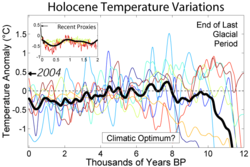Temperature record
|
|
The temperature record shows the fluctuations of the temperature of the atmosphere and the oceans through various spans of time. The most detailed information exists since 1850, when methodical thermometer-based records began. There are numerous estimates of temperatures since the end of the Pleistocene glaciation, particularly during the current Holocene epoch. Older time periods are studied by paleoclimatology.
Instrumental_Temperature_Record.png
Global surface temperatures
| Contents |
The Instrumental Period: from 1850
Main article: Instrumental temperature record
The most detailed information exists since 1850, when methodical thermometer-based records began.
Tropospheric temperature (the satellite and balloon temperature records)
Main article: Satellite temperature measurements
Satellites have been measuring the temperature of the troposphere since 1979. Ballon measurements begin to show an approximation of global coverage in the 1950's.
Proxies: tree rings, ice cores: the last 2000 years
2000_Year_Temperature_Comparison.png
Main article: Temperature record of the past 1000 years
Longer records exist from proxies: quantities such as tree-ring widths, coral growth or isotope variations in ice cores. From these, proxy temperature reconstruction of the last 2000 years have been made for the northern hemisphere. [1] (http://www.grida.no/climate/ipcc_tar/wg1/figspm-1.htm) [2] (http://www.grida.no/climate/ipcc_tar/wg1/069.htm#fig220) However, coverage of these proxies is sparse: even the best proxy records contain far fewer observations than the worst periods of the observational record. Also, problems exist in connecting the proxies (e.g. tree ring width) to the variable of interest (e.g. temperature).
Indirect historical proxies
As well as natural, numerical proxies (tree-ring widths, for example) there exist records from the human historical period which can be used to infer climate variations, often in a less directly numerical way: reports of Frost Fairs on the Thames; records of good and bad harvests; dates of spring blossom or lambing; extraordinary falls of rain and snow, and unusual floods or droughts. These too can be used to infer historical temperatures, but generally in a more qualitative manner than the natural proxies discussed above.
Recent evidence suggests that a sudden and short-lived climactic shift between 2200 and 2100 BCE occurred in the region between Tibet and Iceland, with some evidence suggesting a global change. The result was a cooling and reduction in precipitation. This is believed to be a primary cause of the collapse of the Old Kingdom of Egypt. ([3] (http://www.bbc.co.uk/history/ancient/egyptians/apocalypse_egypt_04.shtml))
Paleoclimate
Main article: Paleoclimatology
Many estimates of past temperatures have been made over Earth's history. The field of paleoclimatology includes ancient temperature records. As the present article is oriented toward recent temperatures, there is a focus here on events since the retreat of the Pleistocene glaciers. The 10,000 years of the Holocene epoch covers most of this period, since the end of the Northern Hemisphere's Younger Dryas millennium-long cooling. The Holocene Climatic Optimum was generally warmer than the 20th century, but numerous regional variations have been noted since the start of the Younger Dryas.
The long term ice core record: the last 800,000 years
Ice_Age_Temperature.png
Even longer term records exist for few sites: one ice core (from Vostok, Antarctica) stretches back 420,000 years [4] (http://cdiac.esd.ornl.gov/trends/temp/vostok/graphics/tempplot5.gif)[5] (http://cdiac.esd.ornl.gov/trends/temp/vostok/jouz_tem.htm); the recent EPICA core reaches 800 kyr; many others reach more than 100,000 years. The Vostok core covers four glacial/interglacial cycles. Two cores GRIP (http://www.ngdc.noaa.gov/paleo/icecore/greenland/summit/document/gripinfo.htm), GISP (http://earth.agu.org/revgeophys/mayews01/mayews01.html) from Greenland stretch back as far as the previous interglacial. Whilst the large-scale signals from the cores are clear, there are problems interpreting the detail, and connecting the isotopic variation to the temperature signal.
Geologic evidence of past temperature changes
Main article: Geologic temperature record
On longer time scales, sediment cores show that the cycles of glacials and interglacials are part of a deepening phase within a prolonged ice age that began with the glaciation of Antarctica approximately 40 million years ago. This deepening phase, and the accompanying cycles, largely began approximately 3 million years ago with the growth of continental ice sheets in the Northern Hemisphere. Gradual changes in Earth's climate of this kind have been frequent during the Earth's 4500 million year existence and most often are attributed to changes in the configuration of continents and ocean sea ways.


